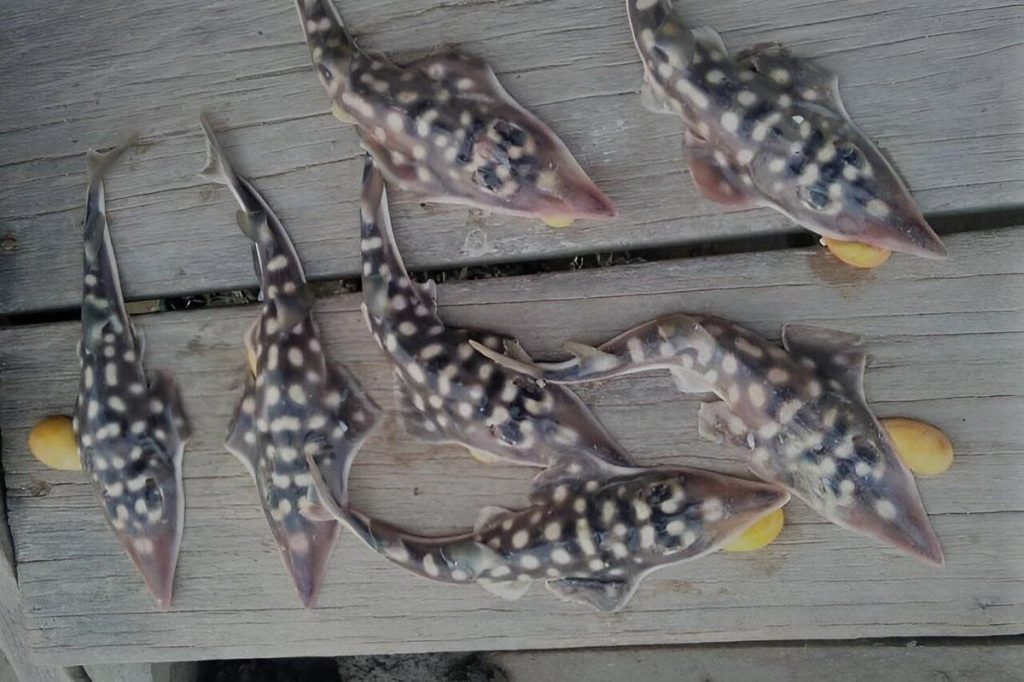In the heart of the picturesque Riau Islands in Indonesia, a multi-national research team comprising scientists from Indonesia, Australia, and the United States is on a thrilling expedition: to uncover the hidden home of one of the world’s most endangered and enigmatic creatures—the Clown Wedgefish. The Clown Wedgefish (Rhynchobatus cooki) belongs to the family Rhinidae, which comprises of fish that have a distinctive flattened body, resembling a combination of a shark and a ray. Their most striking feature is their broad, wedge-shaped head, which gives them their common name. One of the most captivating aspects is its intricate coloration; they often sport a unique pattern of dark spots and bands, resembling clown-like markings, hence their common name. This intricate coloration aids in camouflage and helps them blend into their sandy or muddy seabed habitats.
This elusive critter has long eluded scientific scrutiny, with sightings confined solely to fish markets in Singapore and Jakarta. However, the recent discovery of social media posts by local fishers hinted at the Clown Wedgefish’s potential habitat in the southwest Riau Islands of Indonesia—a revelation that has spurred this ambitious research mission. Now a group of dedicated researchers from Charles Darwin University (CDU), the University of Southern Mississippi (USM), and Universitas Maritim Raja Ali Haji (UMRAH) is determined to unveil its secrets and safeguard its future. Dr. Peter Kyne, Senior Research Fellow at CDU, underscores the critical importance of their mission in devising a conservation strategy for this endangered species. “Clown Wedgefish are incredibly rare and are in decline having been impacted in a significant way by fishing,” Kyne told Phys.Org. “Our research is trying to understand the habitat of the Clown Wedgefish, for example if they live around coral reefs, mangroves, or on sand. This information will then help us to develop conservation and management plans for the species.”
The expedition recently set its course for Singkep Island in Indonesia—one of just four suspected strongholds of the Clown Wedgefish. Associate Professor Dr. Nicole Phillips of USM and graduate student Emma Humphreys led the team in employing targeted environmental DNA water sampling techniques to detect the presence of Clown Wedgefish in the area. The team meticulously encircled the island, situated to the east of Sumatra, amassing a comprehensive collection of samples from the coastal zone and neighboring small islands. Dr. Phillips explained their approach, saying, “During our fieldwork we were able to collect 100 samples from 33 sites around the island. Fish shed DNA through their scales, mucus, and excrement and this gets released into the environment. The water samples will be screened to see if they contain DNA from the Clown Wedgefish. This will help us to pinpoint the habitat of the Clown Wedgefish.”
The research not only contributes to our understanding of the Clown Wedgefish but also supports the Ph.D. project of CDU student Ms. Benaya Simeon. Her work delves deeper into deciphering the geographic range, habitat, and threats faced by this elusive species. “The susceptibility of the species and the intensity of fisheries requires robust research to inform conservation plans and regulations for its management,” emphasized Ms. Simeon. “Indonesia is dominated by small scale fishers which have high a dependency on marine resources. It is important to save the Clown Wedgefish as a species unique to these islands.” As part of her Ph.D., Ms. Simeon plans to embark on more field trips, engaging with local fishers and traders to gain valuable insights into their interactions with the species. Furthermore, the research team has enlisted the support of local community members who vigilantly monitor the appearance of Clown Wedgefish in the bustling local fish markets.
This international collaboration, supported by the Save Our Seas Foundation, aspires to secure a brighter future for the Clown Wedgefish. With each water sample and field expedition, these dedicated scientists are inching closer to unraveling the secrets of the Clown Wedgefish’s hidden world, ensuring that this elusive creature remains a part of the rich tapestry of life in our oceans for generations to come.
Read the full article here










